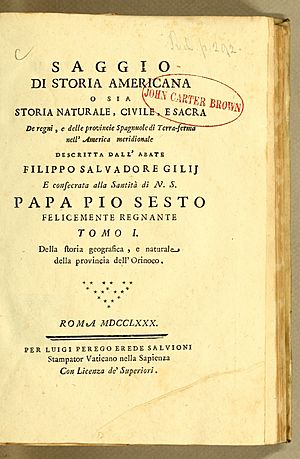Filippo Salvatore Gilii facts for kids
Filippo Salvatore Gilii (also known as Felipe Salvador Gilij in Spanish) was an Italian Jesuit priest who lived from 1721 to 1789. He spent time in the Province of Venezuela, which is now central Venezuela, near the Orinoco River. Gilii is well-known in the study of early South American linguistics because of his smart ideas about how languages work. He was born in Legogne, Italy, in the Umbria region. Much of what we know about the Tamanaco people comes from Gilii's writings.
One of his most important books was Saggio di Storia Americana. Its full title means "Essay on American History, or Natural, Civil, and Sacred History of the Spanish Kingdoms and Provinces of Mainland South America." This book was first published in four parts in 1768. In 1998, the Venezuelan government even made a special stamp to honor him.
What Did Gilii Discover About Languages?
Gilii was very advanced for his time in understanding languages. He noticed how sounds in different languages could be related. For example, he saw patterns between sounds like /s/, /tʃ/, and /ʃ/ in the Cariban language family. This idea of languages being related through their sounds came before William Jones suggested similar ideas. Gilii was special because he also showed proof for his theories.
He also talked about many other big ideas in language study. These included:
- Areal features: When unrelated languages spoken in the same area start to share some features.
- Loanwords: Words borrowed from one language into another. He saw this happening between American languages and also from American languages into European ones.
- Word order: How words are arranged in a sentence.
- Language death: When a language stops being spoken by anyone.
- Language origins: Where languages come from.
- Nursery forms: The simple words babies use when learning to speak, like "mama" or "dada."
Gilii's Nine "Mother Languages"
Gilii studied the languages spoken around the Orinoco River. He found that they belonged to nine main groups, which he called "mother languages" (lenguas matrices). These are like what we call language families today. His classification was one of the first to group South American languages.
Here are the nine "mother languages" Gilii identified:
- Caribe (Cariban)
- Sáliva (Salivan)
- Maipure (Maipurean)
- Otomaca & Taparíta (Otomacoan)
- Guama & Quaquáro (Guamo)
- Guahiba (Guajiboan)
- Yaruro
- Guaraúno (Warao)
- Aruáco (Arhuacan)
This way of grouping languages was a very early and important step in understanding the many languages of South America.
See also
 In Spanish: Filippo Salvatore Gilii para niños
In Spanish: Filippo Salvatore Gilii para niños
- Classification of indigenous languages of the Americas
- Lorenzo Hervás y Panduro


